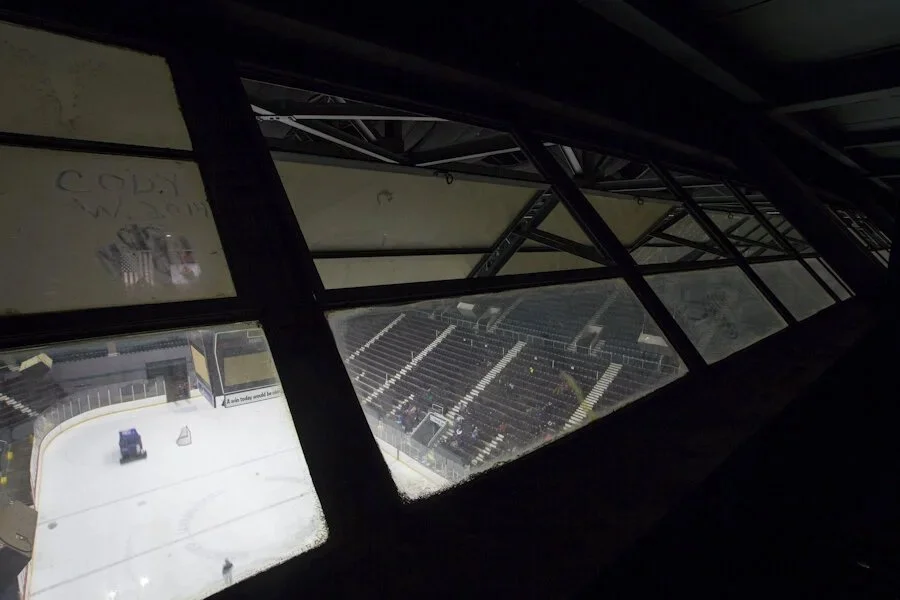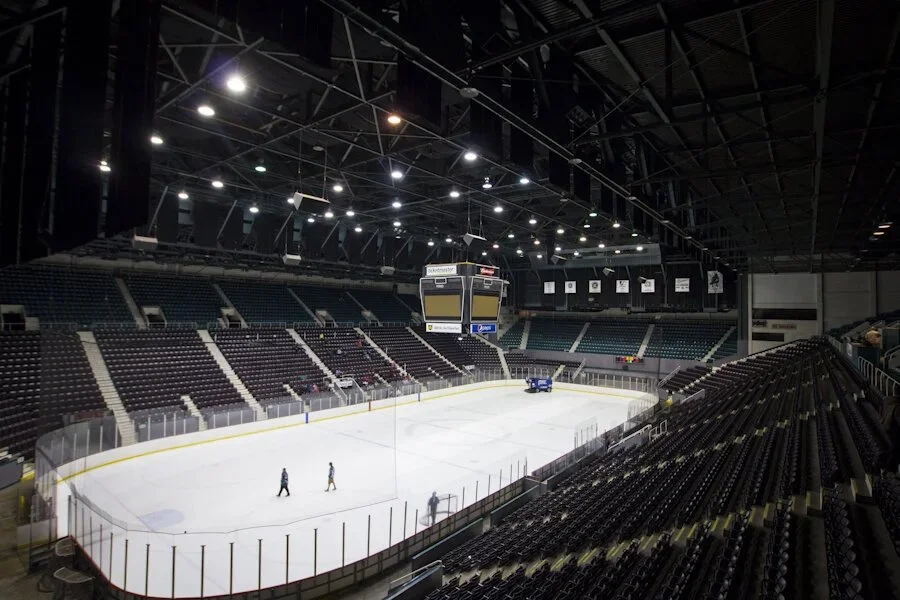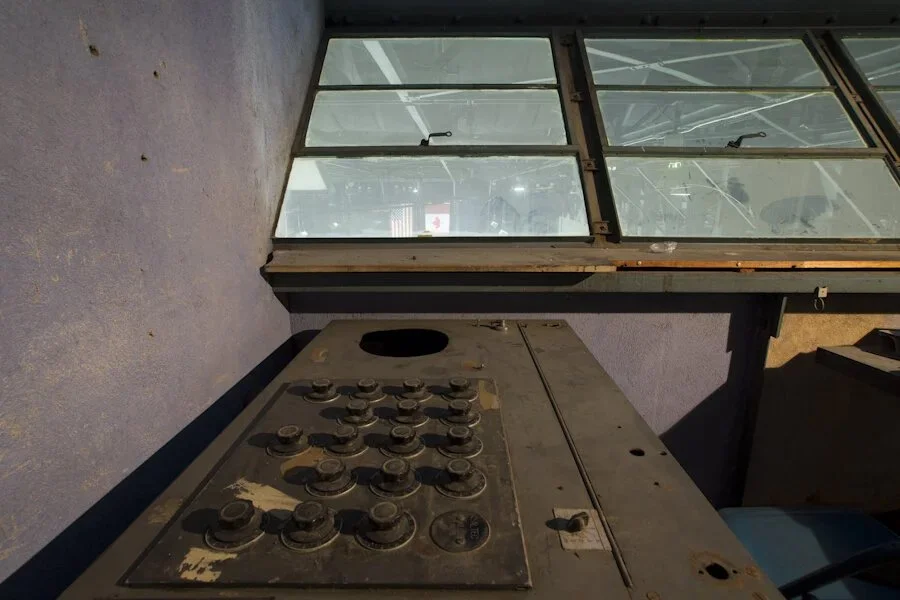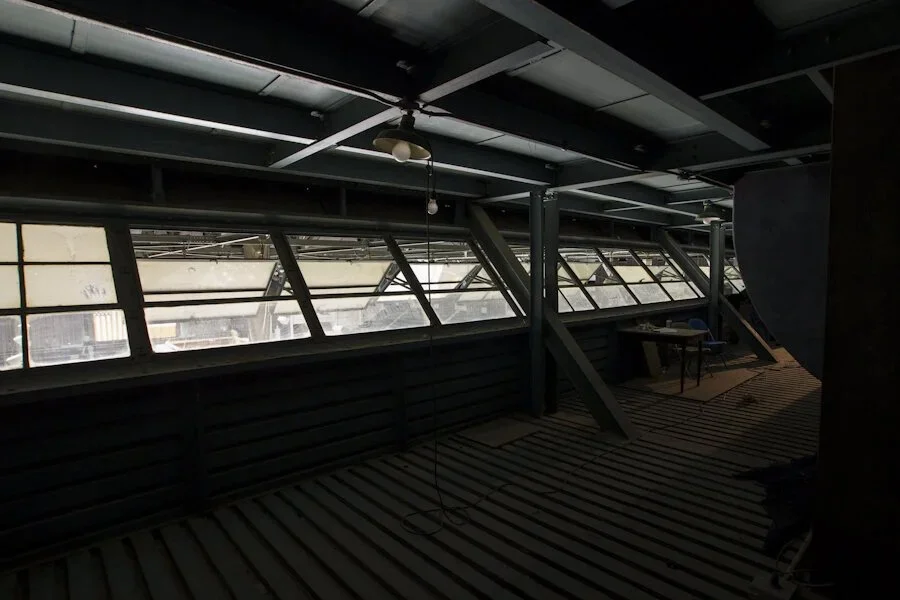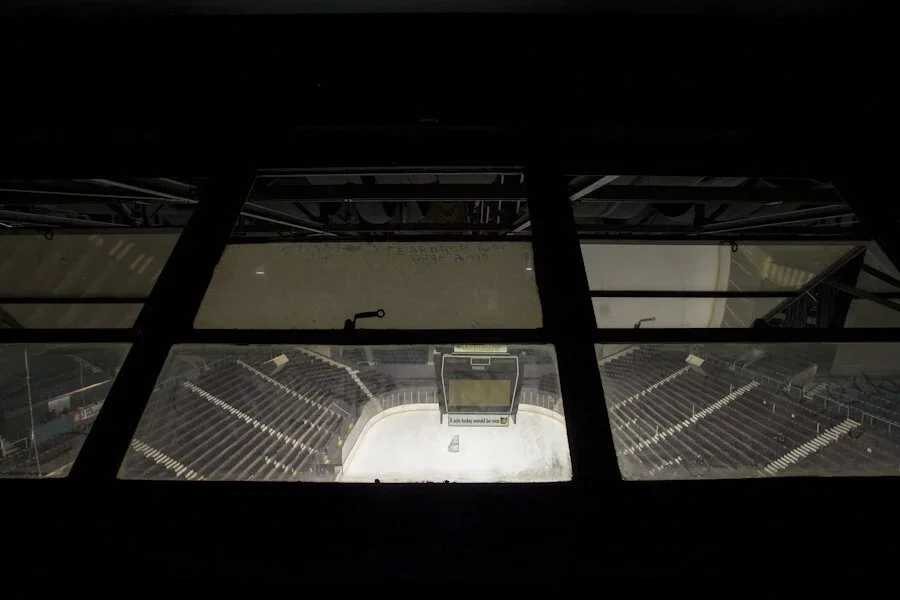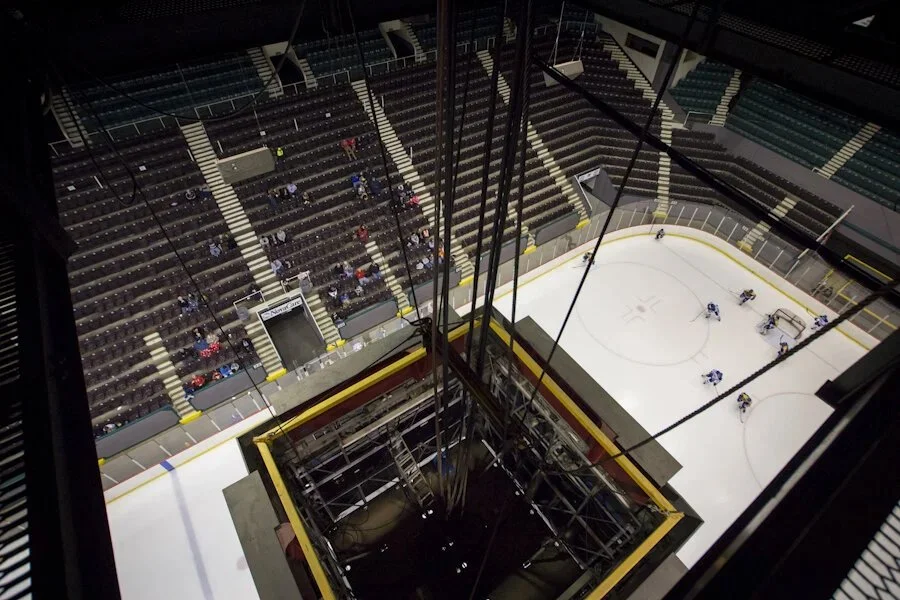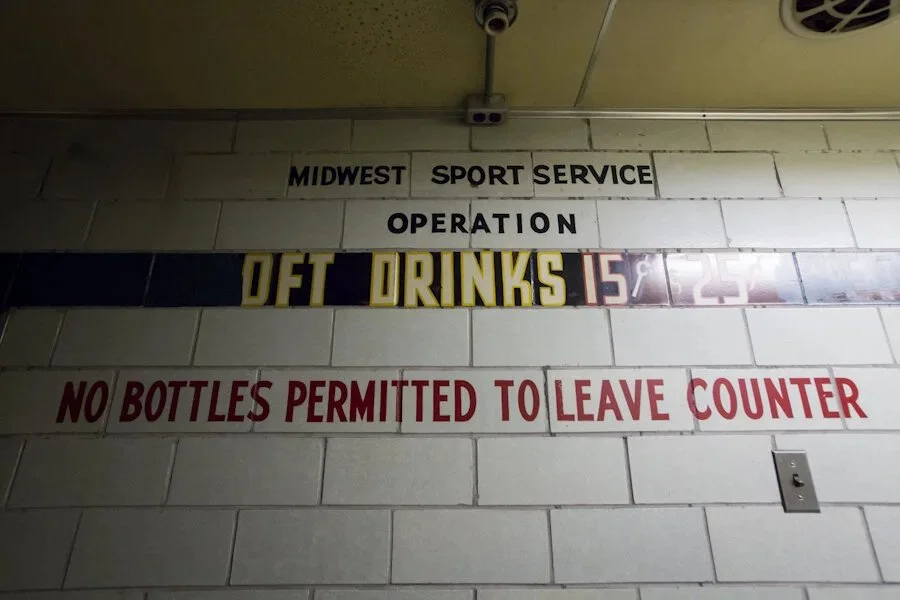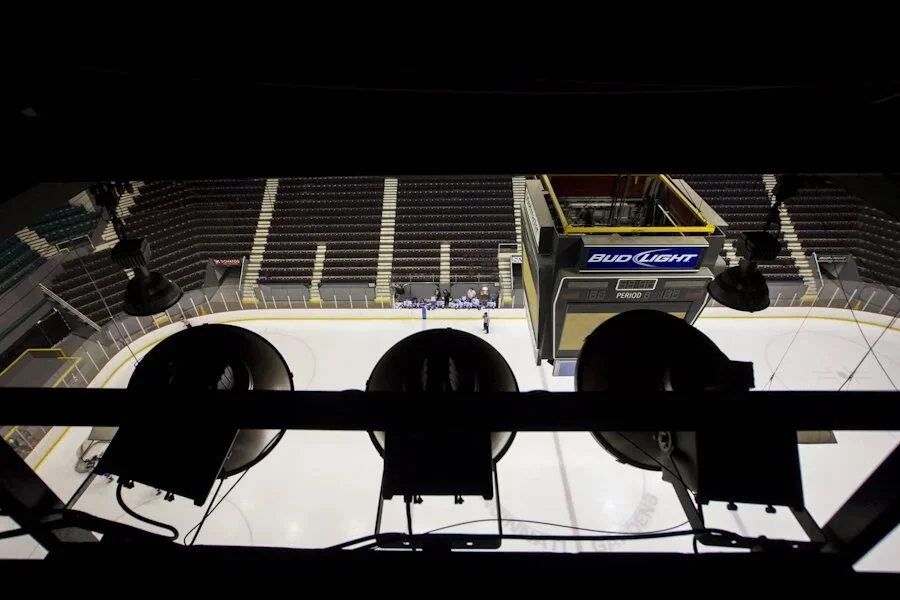The Cincinnati Gardens and The Press Box That Never Was
In the rafters above the city’s classic arena, there’s a story of history and a unique view.
The Cincinnati Gardens in the city's Bond Hill neighborhood as seen in its hockey configuration.
I can still remember the first Cincinnati Mighty Ducks game my dad and I attended, their debut match in 1997—taking the Paddock Rd. Exit just as the sun was starting to set. As we rounded the curve on Seymour Ave, the sun lit up the brick façade and bold white letters: "CINCINNATI GARDENS."
We parked in the lot across the street, crossing at the direction of police officers burning their red colored flares in the road. I still remember how the Gardens smelled that night, how it still smells today: like popcorn and light beer. They took our tickets, we walked past the news cameras and then through a corridor filled with cold air coming in from the arena floor. We made the steep climb to our seats, taking our place against the wooden backs and settling in for an evening with the American Hockey League one step below the NHL.
The Ducks are gone now, having left in 2005. The Gardens remains though in its familiar way. It's not the first time I've written about the city's hockey barn. I've done stories about its history, monster trucks, the circus that comes through, and the roller derby team that still calls it home. Those don’t even account for the multitude of other events I’ve seen there such as arena football and indoor soccer. I'm just one of many who have come through its turnstiles and formed memories. No matter how many times I visit, I can't get over it. I love this place, I love its history. The building isn't contemporary like Nationwide Arena of nearby Columbus and even lacks some of the amenities seen in downtown’s mid 70’s, once renovated, thrice renamed US Bank Arena. However, the Gardens has an undeniable charm. It’s a definitive and iconic piece of this city - part of our identity.
There's always something new to learn about the place. A walk through its Legends Museum always reveals another great story. Yet, after all the events and all the time spent wandering the corridors, there was one thing I always wanted to know. It was a question that came up during that Ducks game in 97, one posed by my 8 year old self to my Dad: "What is that room up top?"
Above the arena floor, a room seen in the rafters. Below it hang banners representing some of the arena's former tenants: The Mohawks, Swords, Cyclones and Mighty Ducks hockey teams as well as the Commandos arena football team.
That night and the years that passed never delivered an answer. They didn't look like luxury suites and the concept of such plush seating didn't really exist when the building opened on a Tuesday night in February 1949. At events over the years, I started to notice how the windows of the structure were noticeably dust covered, even from the floor below - just another one of the building's curious quirks. Oftentimes my friend Ryan and I would attend an event just to have an excuse to visit the building. We'd dine on nachos and take in whatever indoor soccer, recreational men's hockey league or arena football team was making a go of it, occasionally glancing up to speculate about the room up top. No one ever seemed to have a definitive answer though and the lack of one just added to the Gardens' historic mystique.
Then an answer came when my dad and I were offered an exclusive tour through a confidential source. We found ourselves once again taking the Paddock Rd. Exit, seeing those white letters in the fading sun and inhaling the scent of beer and popcorn. We took the stairs to the rafters and made our way over to the structure best described as "the skybox."
The interior of "the skybox" in the rafters above the arena.
The building's old blueprints label this area as "undecided," but as the story goes: the structure was originally supposed to be the press box. Likely envisioned as a spacious facility with a bird's eye view, the rooms in the rafters never saw a member of the conventional sports media.
The view of the arena floor/playing surface from "the skybox." Precariously leaning forward and looking straight down affords a full view, but remaining in a regular seated position offers an obstructed one.
As seen in the above photograph, it's tough to get a clear angle of the entire floor through the windows. It can be done by leaning forward and having to nearly look straight down. As the building neared completion, the proposed press box's problems were apparently realized and a new one was worked into the design. The press box that exists today, a wooden structure among spectators at the top of the lower seating bowl, is the one the building opened with. When the Gardens held its grand opening on a February night in 1949, this final press box drew the ire of reporters. The media's poor accommodations in this afterthought were a bit of a let down for what was then seen as a state-of-the-art arena. Amongst a flurry of praise for the new facility, The Cincinnati Enquirer reported one drawback:
"Sour Notes at the opening were sounded by the scribes who claimed that the press box was lifted bodily from some antique country ballpark. It was decided that the easiest way to type was to reach under the arms of the man in front of you and write on his machine."
- ‘The Cincinnati Enquirer,’ February 1949.
The cramped quarters of today's press box were a result of nixing the original plans to use what became the mysterious room up top. Nevertheless, the "skybox" in the rafters still served a purpose as it housed the control's for the building's lighting and audio systems.
The former control panel for the arena's lights.
The no-longer-used panels include handwritten notes for which buttons adjust the lights for events like hockey, basketball and boxing. Old wires hang on the walls, collecting dust along with the windows and floor.
Former controls for the audio system.
The room still houses the controls for the arena's present day sound system. That equipment sits right behind an antique panel of knobs which controlled the original audio set up. Meanwhile, the next room over is dark and empty. This is where the press box was originally intended to go, high above the average spectator and the action below.
The area of "the skybox" that was intended to be the press box.
Again, the view from up here is impressive, but it's clear why it wouldn't be conducive to writers reporting on any kind of event. In most arenas (and how things eventually came to be here), the press box is situated midway on the horizontal end of the event floor. In the "skybox," you view the action vertically as opposed to horizontally and you really have to work to see what's below you.
Standing a few feet back from the windows wouldn't allow a reporter to see even half of the floor.
Meanwhile, the press box that did get built and was once derided as being from "some antique country ballpark," has garnered a positive reputation. "I've been in the press box for games in NHL buildings such as Anaheim, Buffalo, Chicago, Columbus, Detroit, Edmonton, Philadelphia, and more than 65 buildings from my years in the AHL, ECHL and old IHL. None of them offered the sight lines you have at the Cincinnati Gardens," Don Helbig told me.
While these days Don is known as Kings Island Amusement Park's PR guy, he has an extensive pro hockey resume. Before he was announcing new roller coasters, Don was the marketing face and radio announcer for the Cincinnati Mighty Ducks hockey team and the Cincinnati Cyclones who played in the building before them. He says of the real press box:
"Whether you were broadcasting the game, covering it as a writer, or the media relations director, it's a great place to work a hockey game."
Don continues his announcing career today doing play by play for the Cincinnati Thunder, a junior league team that began playing at the Gardens in 2015. His color commentator is my aforementioned friend Ryan, the same guy who used to join me in looking for any excuse to visit the historic arena.
I could see the two of them calling a game from the rafters above the scoreboard, connected to the "skybox" via a series of catwalks. While the view from up here is dynamic, the press box that came to be definitely echoes the building's reputation for stellar views of the ice.
From the rafters above center ice, the press box that did come to be is seen below center.
On opening night in 1949, The Gardens hosted an exhibition hockey game between the minor league Dallas Texans and the major league Montreal Canadiens. That night was one of the Queen City's first introductions to professional hockey. The event was followed up by basketball games featuring the University of Cincinnati and Xavier against Butler and Kentucky respectively on separate evenings. That first week would end up being capped off with a boxing match featuring local legend Ezzard Charles. "The Cincinnati Cobra" would go on to defeat Joey Maxim in 15 rounds.
Joey Maxim facing the Queen City's own Ezzard Charles. Known as "The Cincinnati Cobra," Charles would go on to defeat Maxim in 15 rounds at one of the building's first events.
Image courtesy of The Cincinnati Gardens.
The arena secured its first full time tenant when it purchased an American Hockey League franchise and dubbed them the Cincinnati Mohawks. The Mohawks were one step below their parent club, the Montreal Canadiens, who had opened up the building earlier that year. After switching from the AHL to the International Hockey League, the Mohawks would go on to win six regular season titles and five league championships.
The "skybox" is accessed via a series of catwalks that also lead to an area above the building's scoreboard.
Despite their success, the Mohawks eventually folded. They were followed up in subsequent years by other minor league hockey teams such as the Wings and Swords. In 1990, the Cyclones made their debut. After moving to US Bank Arena downtown, the Mighty Ducks (an AHL affiliate of the NHL club with the same name) occupied the Gardens in lieu of the 'clones.
Former lighting controls in the "skybox."
The building has hosted a slew of other events from Richard Nixon to the Beatles to Ice Capades to Olympic style swimming to motorcycle jumping and so much more. Its reputation for hockey is followed closely with a reputation for basketball. The NBA's Sacramento Kings, once known as the Cincinnati Royals and lead by the legendary Oscar Robertson, used to call this building home. At one point, the arena's seats were painted blue during Xavier University's 17 years of using the facility as their home court. The University of Cincinnati also had a short stint as a tenant while the minor league Continental Basketball Association's Cincinnati Slammers made a short run just before UC. An excellent recap of everything the building has seen can be found on their website, authored by the previously quoted Don Helbig. The building also features an incredible "Legends Museum," curated by employees that care deeply and passionately for the building's legacy.
A small sample of the collection housed within the Legends Museum.
On June 10, 2014, I wrote an article about the Cincinnati Rollergirls last match of the 2014 season. The building had recently been put up for sale then and rumors began to float. There was a chance that roller derby match would possibly be the last event in the building's history. No news came though and while the building is still currently for sale, the next chapter in the story of the arena on Seymour Street has yet to be written.
Vintage concession prices and advertising tucked away in a back area of the Gardens.
The Gardens has solidified its reputation as not just a hockey palace, but as a local icon. Talk to any native and there's a good chance they'll recall a memory about something they've seen there. The Gardens holds history within its walls and a place in the city's heart. While the "skybox" above the arena floor never saw the light of day as a press box, it's still an interesting link to the building's past when it was originally known as the "Garden" as opposed to the "Gardens." So many events, so many teams, so many spectators and so many Cincinnatians have played out below those dusty windows. Perhaps the best place to contemplate the building's history and think about its future isn't just in a museum and our memories, but from the rafters above.
Update | Oct. 22, 2017:
I'm sad to report that the Gardens is set for demolition. Was able to snag a seat from there, though.
Update | March 13, 2018:
The Gardens has now been demolished. I was able to visit one last time while the place was coming down.
